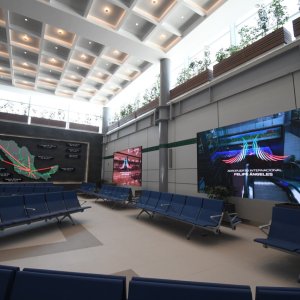
Mexican Airports Face Tough Period, Strengthen Health Measures
 By Alicia Arizpe | Senior Writer -
Thu, 06/25/2020 - 12:58
By Alicia Arizpe | Senior Writer -
Thu, 06/25/2020 - 12:58
Mexico’s aviation industry continues grappling with the effects of the COVID-19 outbreak. As airlines grounded most of their fleets, airport operations continue at the bare minimum allowing to strengthen hygiene measures to prevent the spread of the virus.
While the COVID-19 outbreak began to wreak havoc in Mexico’s aviation industry as early as March, its effects intensified during April and May with all airlines reporting sharp decreases in demand, surpassing 90 percent in some cases. Aeroméxico reported that its demand measured in revenue passenger kilometers (RPK), calculated by multiplying the number of paying-passengers by the distance they traveled, fell by 94.4 percent year-on-year during May. Low cost airlines reported similar situations, with Viva Aerobus reporting an 85.71 percent decrease in RPKs for the same month and Volaris an 88.1 percent decrease in RPMs, as the latter airlines reports its figures in miles.
The significant decrease in passengers also caused trouble for airports, which saw some of the lowest traffic in recent history. Mexico’s largest travel hub, Mexico City International Airport (AICM), saw only 275,975 passengers during May, a sharp decrease from May 2019’s 4.35 million. This 93.7 percent decrease in passengers surpasses the fall the airport had seen the previous month when the number of passengers fell by 92.8 percent year-on-year. Other airports found themselves in a similar situation. The second largest airport in the country by passenger traffic, Cancun International Airport (AIC), saw only 48,610 passengers during May 2020, 97.7 percent less than the 2.12 million of the previous year. Guadalajara International Airport (AIG), the third largest in the country, also saw a sharp fall in traffic, reporting a 90.4 percent drop.
The decrease in passengers has been felt across most of Mexico’s airports, according to the country’s airport groups. Grupo Aeroportuario del Pacífico (GAP), which operates 13 airports including AIG, reported a 90.8 percent reduction in passer traffic for the month across all its airports. The sharpest fall was seen in international passengers, which fell by 91.7 percent in comparison to the 89.8 percent in domestic passengers. The group points to the prolonged confinement measures as the reason behind the heavy drop in traffic. “Confinement levels remained high throughout May, causing the cancellation of a large number of national and international flights,” said GAP’s monthly report.
Grupo Aeroportuario del Sureste (ASUR), which operates nine airports including AIC, reported a similar situation with passenger traffic falling by 96.6 percent year-on-year due to the reduction of business and leisure trips. For ASUR, the fall in international passengers amounted to 99.3 percent, while domestic traffic shrank by 94.3 percent. Grupo Aeroportuario del Centro Norte (OMA), which operates 13 airports in Mexico including the fourth largest in the country, Monterrey International Airport, also reported a total drop in passenger traffic of 93.5 percent, with national passenger traffic falling by 93.1 percent and international traffic by 96.4 percent.
Fear of the virus remains among the top reasons holding people back from traveling again. To address these fears and keep passengers safe, local airports have implemented a series of measures to protect travelers. These include mandatory use of face masks, temperature screenings and asking travelers to fill comprehensive surveys to assess their travel risks. Associations across the globe led by the International Civil Aviation Organization (ICAO) have also developed a series of measures aimed to protect passengers at all stages of their trip. These guidelines, compiled in the document “Takeoff: Guidance for Air Travel Through the COVID-19 Public Health Crisis,” provide a framework for the layered implementation of safety measures that minimize exposure risks for passengers.
This document was created by ICAO, the International Air Transport Association (IATA), Airports Council International (ACI) and the Civil Air Navigation Services Organization (CANSO), among other organizations, to provide a gradual return to operations for the paralyzed industry. It introduces a series of recommendations for airports, airlines and crews aiming for a safe increase in passenger traffic that will allow a gradual transition to high-volume domestic and international travel. “Restoring public confidence in air travel has very broad benefits. This is not only about the operational and economic viability of the air transport sector, but of entire societies and regions having their economic livelihoods and stability restored,” said Fang Liu, Secretary General of ICAO.
ICAO’s recommendations to airports include regular cleaning and disinfection of terminal buildings and all equipment following WHO’s Guide to Hygiene and Sanitation in Aviation. It also suggests restricting access to terminals to workers and passengers, unless the latter have disabilities, and enforcing physical distancing of at least 1m between all passengers and airport personnel. The latter should also be provided adequate personal protective equipment based on their risk of exposure. When possible, the use of self-service kiosks for check in or baggage tagging, drop off and pick up, should be encouraged to minimize face-to-face contact. These measures should also be continuously revisited and modified, replaced or eliminated as necessary as the outbreak evolves.
The gradual return to operations is of increasing importance to an industry that is expected to see US$434 billion in revenue evaporate due to the outbreak during 2020. Mexico’s aviation sector can lose up to US$6.4 billion during the year according to the National Chamber of Air Transport (CANAERO). Moreover, the sector might not fully recover until 2024, warns the chamber, which is currently prioritizing the implementation of sanitary measures that ensure passengers feel safe to travel.
















